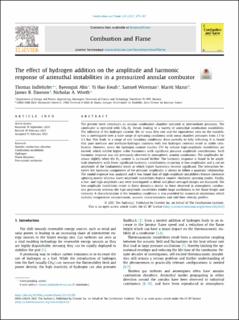| dc.contributor.author | Indlekofer, Thomas | |
| dc.contributor.author | Ahn, Byeonguk | |
| dc.contributor.author | Kwah, Yi Hao | |
| dc.contributor.author | Wiseman, Samuel | |
| dc.contributor.author | Mazur, Marek | |
| dc.contributor.author | Dawson, James | |
| dc.contributor.author | Worth, Nicholas | |
| dc.date.accessioned | 2021-03-08T10:09:09Z | |
| dc.date.available | 2021-03-08T10:09:09Z | |
| dc.date.created | 2021-03-01T09:04:55Z | |
| dc.date.issued | 2021 | |
| dc.identifier.citation | Combustion and Flame. 2021, 228, . | en_US |
| dc.identifier.issn | 0010-2180 | |
| dc.identifier.uri | https://hdl.handle.net/11250/2732101 | |
| dc.description.abstract | The present work introduces an annular combustion chamber operated at intermediate pressures. The combustor is operated with CH-H blends leading to a variety of azimuthal combustion instabilities. The influence of the hydrogen content, the air mass flow rate and the equivalence ratio on the instabilities is investigated over a wide range of operating conditions with mean chamber pressures from 1.5 to 3.3 bar. This leads to a range of exit boundary conditions, from partially to fully reflecting. It is found that pure methane and methane-hydrogen mixtures with low hydrogen contents result in stable combustion. However, when the hydrogen content reaches 25% by volume high-amplitude instabilities are excited, which exhibit higher order harmonics with significant pressure amplitude contributions. Such harmonic response was not previously observed in atmospheric annular combustors. The amplitudes decrease slightly when the H content is increased further. The harmonic response is found to be amplitude dependent with fewer significant harmonic contributions occurring at low-amplitudes and a cut-on amplitude of the fundamental mode at which higher harmonics become significant. The interaction between the harmonic components of the pressure amplitudes is shown to follow a quadratic relationship. The modal response was analyzed and it was found that all high-amplitude instabilities feature clockwise spinning modes whereas lower-amplitude instabilities feature counter clockwise spinning modes. Finally, a low- and high-amplitude case were investigated in detail and phase-averaged images are discussed. The low-amplitude instabilities result in flame dynamics similar to those observed in atmospheric combustors previously whereas the high-amplitude instabilities exhibit large oscillations in the flame height and intensity. A characterization of the boundary conditions is also provided for numerical simulations which includes temperature measurements, acoustic characterization and cold flow velocity profiles. | en_US |
| dc.language.iso | eng | en_US |
| dc.publisher | Elsevier | en_US |
| dc.rights | Navngivelse 4.0 Internasjonal | * |
| dc.rights.uri | http://creativecommons.org/licenses/by/4.0/deed.no | * |
| dc.title | The effect of hydrogen addition on the amplitude and harmonic response of azimuthal instabilities in a pressurized annular combustor | en_US |
| dc.type | Peer reviewed | en_US |
| dc.type | Journal article | en_US |
| dc.description.version | publishedVersion | en_US |
| dc.source.volume | 228 | en_US |
| dc.source.journal | Combustion and Flame | en_US |
| dc.identifier.doi | https://doi.org/10.1016/j.combustflame.2021.02.015 | |
| dc.identifier.cristin | 1894364 | |
| dc.description.localcode | This is an open access article distributed under the terms of the Creative Commons CC-BY license, which permits unrestricted use, distribution, and reproduction in any medium, provided the original work is properly cited. | en_US |
| cristin.ispublished | true | |
| cristin.fulltext | original | |
| cristin.qualitycode | 2 | |

